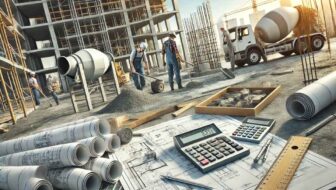Bar Bending Schedule (BBS) Explained: Everything You Need to Know

In construction projects, accurate planning and precise calculations are essential to ensure structural stability. One of the most crucial components for reinforced concrete structures is the Bar Bending Schedule (BBS). If you’re unfamiliar with BBS, it’s a critical process that outlines the types, sizes, quantities, and cutting lengths of steel bars used in construction. Understanding *Bar Bending Schedule (BBS)* can help streamline construction processes, save costs, and ensure that everything is structurally sound.
In this post, we’ll explore everything you need to know about Bar Bending Schedule (BBS), from what it is to how you can easily create one. By the end, you’ll have a clear grasp of the topic and how to effectively implement BBS in construction projects.
What is Bar Bending Schedule (BBS)?
A *Bar Bending Schedule (BBS)* is a detailed list that specifies the quantity, shape, size, and length of reinforcement bars required for construction. BBS is typically created after analyzing the structural drawings and is a key document that aids in the cutting, bending, and placement of bars.
The BBS document is essential because it helps construction professionals maintain accuracy and minimize wastage. By having a detailed schedule, engineers and contractors can ensure they are using the exact amount of steel bars required, thus controlling project costs and ensuring quality.
Importance of Bar Bending Schedule (BBS) in Construction
The use of a *Bar Bending Schedule (BBS)* brings several benefits to the construction process:
1. Precision and Accuracy:
With BBS, the cutting and bending of bars are done as per exact measurements, eliminating guesswork.
2. Waste Minimization:
BBS helps reduce wastage of materials by providing precise lengths and quantities of bars.
3. Cost Savings:
By following the BBS, construction teams can optimize material usage, thus avoiding excess expenditure on steel.
4. Streamlined Project Management:
It ensures that the construction team has clear guidelines, allowing for better workflow and task management.
How to Prepare a Bar Bending Schedule (BBS)
Creating a *Bar Bending Schedule (BBS)* requires a detailed understanding of the structural drawings and reinforcement requirements. Here’s a step-by-step guide:
-
Study the Structural Drawings:
Before preparing the BBS, carefully examine the structural drawings to identify where reinforcement bars will be placed.
-
Determine Bar Shape:
Reinforcement bars can take various shapes, such as straight, bent, or hooked. Identify the bar shapes as per the construction requirements.
-
Calculate the Length of Each Bar:
The length of each bar is calculated based on the dimensions in the structural drawing.
-
Determine Bar Quantities:
Count the number of bars required for each section of the structure.
-
Record Data in the BBS Format:
Organize the information in a table format, listing bar shapes, sizes, lengths, and quantities.
For those in need of assistance with preparing a BBS for their construction project, our BBS Creation & Steel Calculation Services offer expert support in creating accurate bar bending schedules.
Components of a Bar Bending Schedule (BBS)
A typical **Bar Bending Schedule (BBS)** consists of the following components:
- Bar Marking: Identifies each bar with a unique mark for easy reference.
- Diameter of Bars: Lists the bar diameters, commonly available in 6mm, 8mm, 10mm, 12mm, etc.
- Shape of Bars: Indicates the shape of the bar as per the design (L, U, or straight).
- Number of Bars: Specifies how many bars of a particular shape and size are needed.
- Cutting Length: Provides the cutting length for each bar based on the design requirements.
Bar Bending Schedule (BBS) Format
To organize the data effectively, a typical Bar Bending Schedule (BBS) uses a tabular format with the following columns:
| Bark Mark | Dimeter | Shape | Total Length | Cutting Length | Quantity | Remarks |
| B1 | 12 mm | L-shape | 5.6 m | 2.8 m | 12 | – |
| B2 | 10 mm | U-shape | 4.5 m | 2.25 m | 10 | – |
How Bar Bending Schedule (BBS) Improves Efficiency
By using *Bar Bending Schedule (BBS)*, construction teams can enhance their productivity in the following ways:
Time-Saving:
Workers spend less time cutting and bending steel on-site as they have precise instructions from the BBS.
Better Resource Management:
Since BBS minimizes waste, it helps manage materials more efficiently, ensuring that the project stays on budget.
Reduced Errors:
With detailed instructions, there is less room for error, ensuring the construction process runs smoothly.
Common Mistakes in Bar Bending Schedule (BBS)
While Bar Bending Schedule (BBS) is a valuable tool, some common mistakes can undermine its effectiveness:
- Incorrect Measurements:
Ensure accurate measurements from the structural drawings to avoid errors in the BBS.
- Omitting Hooks or Bends:
Always account for hooks and bends when calculating cutting lengths.
- Ignoring Overlap Requirements:
Overlapping bars must be correctly calculated to ensure structural strength.
If you’re looking for everyday essentials or construction tools, check out our online shop for daily use products that offers a wide range of options for your needs.
Conclusion
Understanding and implementing a Bar Bending Schedule (BBS) is crucial for the success of any construction project. It ensures structural integrity, cost-efficiency, and streamlined processes. By following best practices in preparing a BBS, you can ensure that your project stays on track and within budget. Whether you’re a contractor, engineer, or construction professional, having a clear grasp of BBS is essential for your work.
For expert assistance with creating bar bending schedules, structural analysis, and more, consider our Building Plan and Quantity Estimation Services to simplify your next project.
FAQs about Bar Bending Schedule (BBS)
Bar Bending Schedule (BBS) is a document that lists the size, length, shape, and quantity of steel bars required for construction projects.
BBS helps reduce material wastage, optimize costs, and ensure precision in the placement of reinforcement bars.
It is prepared by studying structural drawings, determining the shape and size of bars, and organizing the data in a structured format.
Yes, but using software tools or expert services ensures accuracy and saves time.
By providing precise measurements, BBS ensures that only the required amount of steel is purchased and used, minimizing wastage and reducing costs.

Top 10 Excel Templates for Civil Engineers: Streamline BOQs and Cost Estimation
Did you know that 63% of civil engineers waste over 5 hours weekly on repetitive tasks like manual BOQ preparation...
House Plan and BOQ Bundle: The Perfect Combo for Builders and Contractors
When it comes to residential construction projects, two critical elements ensure smooth execution and cost-effective results: a well-designed house plan...
